Explore Harishchandra Ghat, One Of The Oldest Ghats In Varanasi In 2025
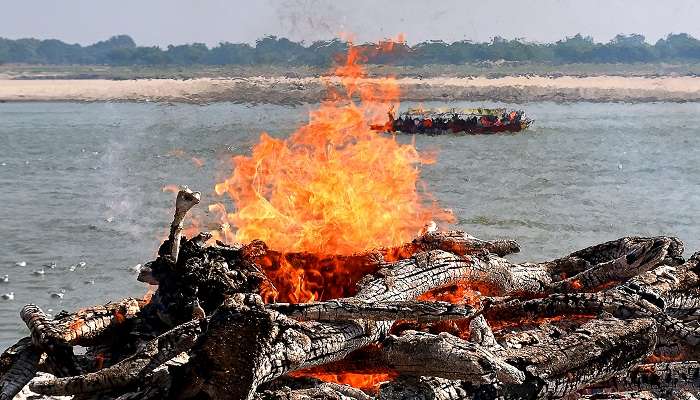
Harishchandra Ghat is the only place where one can witness the rituals of life and death happening. This ghat, situated on the sacred banks of the River Ganga in Varanasi, is named after the legendary king Harish Chandra, who is known for his commitment to speaking the truth and unwavering righteousness. Harish Chandra Ghats hold a cultural and religious significance according to Hindu Mythology. Amidst the flames, flickering wooden logs, and ashes collected, Harish Chandra Ghat invites visitors and tourists to witness the spiritual essence of this place. Visitors with cremation happening right in front of their eyes see the cycle of life and death.
History Of Harishchandra Ghat
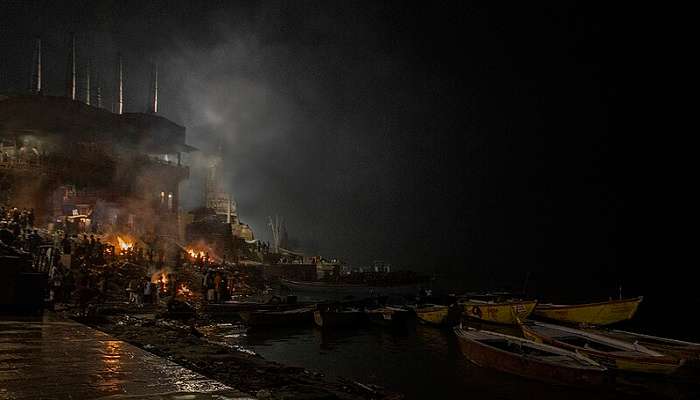
The history of Harish Chandra Ghats can be traced to the times when ancient Varanasi was a hub of pilgrimage, hub and trade. The place is named after King Harish Chandra. The king is known for his strong commitment to truth and righteousness. He once ruled over this city. According to Hindu Mythology, his unwavering commitment to honesty and integrity earned him a place of honour at Varanasi, hence the occurrence of the Harish Chandra Ghat. It is also believed that when the king ruled over this city with unparalleled integrity, he sacrificed his family, the reign and his own identity to preach the principles of truth and righteousness.
The ghat has served as a place for cremation of the dead bodies. It is the solemn site for cremation rituals done where families bid goodbye to their loved ones with the flames flickering right in front of their eyes and echoing chants. The experience is divine and tourists can immerse themselves in knowing what the cycle of life and death holds. According to the ancient texts discovered, this ghat has been bearing cremation for all these centuries.
Must Read: Things to do in Varanasi
Temples Near Harishchandra Ghat
There are certainly plethora of temples in and near the vicinity of Varanasi which also called as the City of Spirituality for a reason, Here we listed two of the important temples near Harishchandra Ghat,
1. Kaal Bhairav Temple
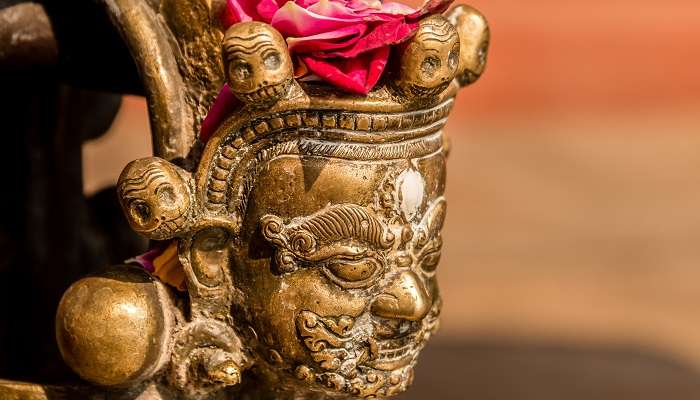
This temple is located within the premises of Harish Chandra Ghat. Kaal Bhairav Temple is dedicated to Lord Bhairava, who is a fierce manifestation of Lord Shiva. Devotees offer prayers here to seek blessings for the protection and prosperity of their families. Also known as ‘The Kotwal Of Varanasi’ ,Kaal Bhairav is considered as the protector of the city, The temple is renowned for its powerful aura and ancient traditions which draws the attention of many devotees.
Timings: 5 AM to 10PM
Entry Fees: Free Entry
2. Mritunjay Mahadev Temple
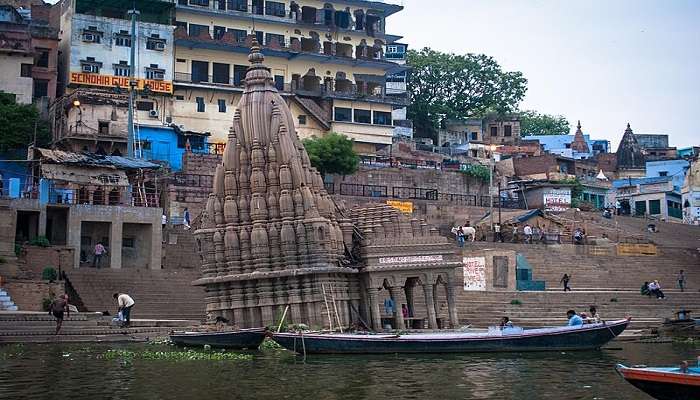
This is another important temple located near Harish Chandra Ghat. It is solely dedicated to Lord Shiva. According to Hindu Mythology, offering prayers to this temple will help the devotees overcome the fear of death and attain spiritual liberation. The temple is famous for its Maha Mrityunjay Mantra, which is believed to grant health and longevity.
Timings: 4AM to 11AM
Entry Fees: Free Entry
Suggested Read: Tulsi Ghat
Places To Visit Around Harishchandra Ghat
Harishchandra Ghat is one of the most visited Ghats in Varanasi. There are other prominent places around this ghat to witness, such as:
1. Kashi Vishwanath Temple

This temple is at a very short distance from Harish Chandra Ghat. The temple is solely dedicated to Lord Shiva. Devotees visit this temple in huge numbers to seek blessings from the god and to glance at the temple’s intricate architecture.
Timings: 3 AM to 11 PM
Entry Fees: Free Entry
2. Manikarnika Ghat
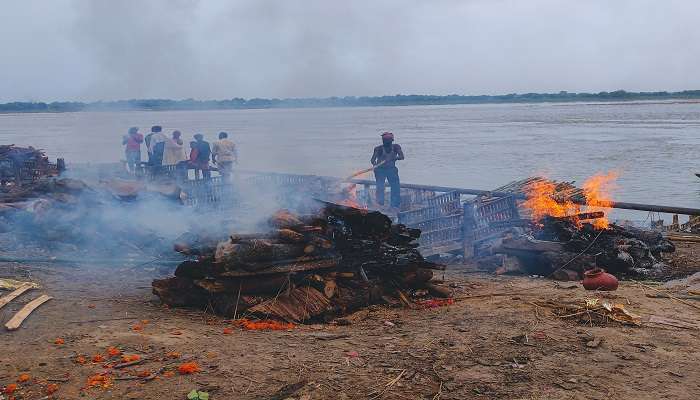
Manikarnika Ghat lies adjacent to Harish Chandra Ghat. This ghat is the oldest in Varanasi and the most used for cremation rituals. Visitors can see the cremation process being performed along with echoing chants spoken by the priests. The ghat truly symbolises the cycle of life and death and how an individual leaves the earth behind by achieving moksha or salvation.
Timings: Open 24 hours
Entry Fees: Free Entry
Suggested Read: Resorts In Varanasi
3. Dashashwamedh Ghat
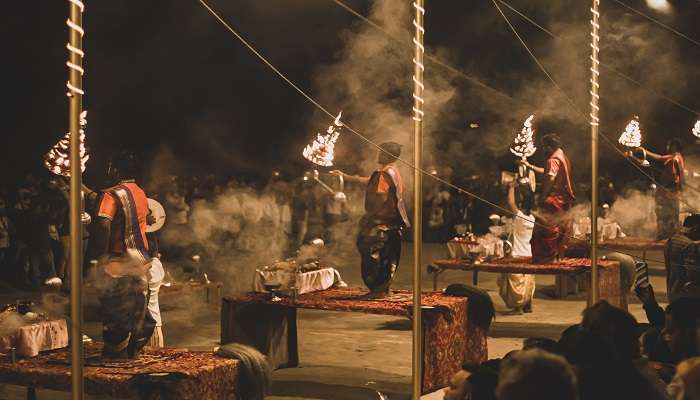
This ghat is one of the most lively and happening ghats on the banks of the river Ganga in Varanasi. The ghat is always packed with crowds coming to witness the very famous “Ganga Aarti” and other rituals. The Aarti Ceremony is held every evening at sunset. The priests perform certain rituals to seek blessings from the sacred river.
Entry Fees: Free Entry
Timings: Open 24 hours
Local Cuisine Served In Harishchandra Ghat
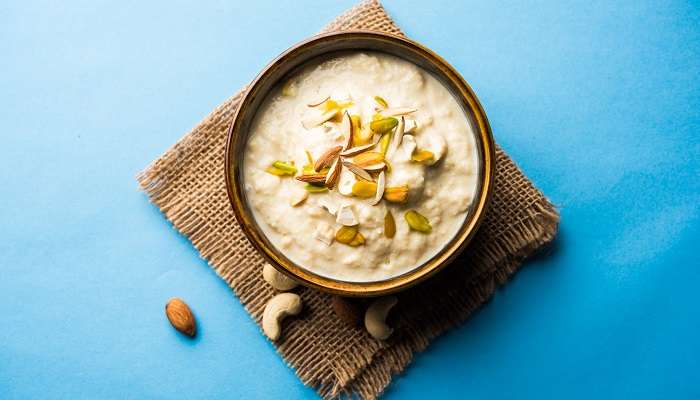
While the ghat is primarily known for its spiritual significance and religious rituals, it also offers an array of cuisines that are a must-try when you visit Varanasi.
1. Lassi: Lassi is made from yoghurt, sugar, and fruit and spice flavourings. It is a beverage served to visitors to provide relief from heat.
2. Baati Chokha: This dish originated in Uttar Pradesh and is a must-try for visitors. In this dish, Baati, a dense bread made from wheat flour, is served with Chokha, a gravy made from roasted eggplant, tomatoes, onions and garlic and flavoured with spices. This is a nutritious meal which is enjoyed by both locals and tourists.
3. Puri Sabzi: Puri Sabzi is the only Indian classic dish served for breakfast, lunch, and dinner. It has Puri, a deep-fried bread made from wheat flour, served with spicy and flavourful potato curry. The crispy texture of Puri, when eaten with this delightful potato curry, simply leaves you in wonder.
4. Samosa: Samosa is a popular snack in India. Popular vendors sell it at these ghats. These triangle pastries are filled with a mixture of potato, peas, and spices, deep-fried, and served with mint or coriander chutney.
5. Rabri: Rabri is a thick, creamy dessert served in Varanasi. It is made from simmering milk until it thickens. It is later garnished with cardamom, saffron and nuts for a delightful experience.
Further Read: Temples In Varanasi
Over the centuries, the Harishchandra Ghat has been witnessed as the sole site of cremation at the River Ganga banks. This ghat bustles with activity that goes on throughout the days and nights. The priests, the mourners and the family members come together to perform rituals and pray for the soul leaving the earth behind. Despite the passage of time, the spirit and purpose of Harish Chandra Ghats have been unyielding. Pilgrims from all walks of life come together to this place to seek blessings. Your trip to Varanasi would inspire and embrace the path of truth and righteousness.
For our editorial codes of conduct and copyright disclaimer, please click here.
Cover Image Source: Shutterstock
Frequently Asked Questions About Harishchandra Ghat
Why is Harishchandra Ghat famous
Harishchandra Ghat is two of the famous cremation ghats in Varanasi situated on the banks of the river Ganga. The other one is Manikarnika Ghat. Hindu Pilgrims from the entire country bring the dead bodies of their relatives to be cremated at this place so that they achieve Moksha or salvation.
What is the difference between Manikarnika and Harishchandra Ghat?
Manikarnika Ghat. Harish Chandra Ghat is where cremation rituals are carried out. Manikarnika is also known as Adi Manikarnika, the original cremation ground. Harishchandra Ghat is much smaller than Manikarnika Ghat.
What is the story of Raja Harischandra in Varanasi?
Raja Harish Chandra once ruled the kingdom of Varanasi. He was only committed to speaking the truth and performing the deeds of righteousness. The story says that once, in his dream, he saw himself giving the kingdom to the Sage Vishwamitra. The sage asked for an additional 500 coins after he gifted the kingdom to him.
What is the myth of Manikarnika Ghat?
According to Hindu Mythology, it is believed that the Manikarnika Ghat is cursed. It is under the strong influence of a curse that is said to bring misfortune to those who interfere with the sacred rites or disrespect the place. The fire never extinguishes at this place.
What is the relationship between Harishchandra and Ram?
Raja Harishchandra was a fearless but truthful ruler who once ruled the kingdom of Varanasi. It is believed that the king belonged to the lineage of Lord Ram. The father of Harish Chandra, Jayachandra was also a well-known ruler of Ayodhya.
People Also Read:
Manikarnika Ghat Panchganga Ghat Shivala Ghat

Passionate Marketing Student with a flair for storytelling, eagerly embarking on a journey within the vibrant world of travel. Excited to merge analytical acumen with creative skills to elevate the editorial landscape of the travel industry.











